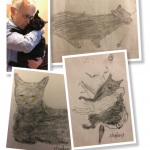TR: For you, medicine is a multi-generation family endeavor. Why did you specialize in the intersection of rheumatology and ophthalmology, and how did your family influence that decision?
Dr. Rosenbaum: My formal training is in internal medicine and rheumatology. As a fellow in the 1970s, I wanted to establish a rodent model that would be informative for spondyloarthritis. I injected rats with killed bacteria in the footpad. I chose bacteria that were known to trigger reactive arthritis. The rats developed eye inflammation and no joint inflammation. When the pathologist told me the rats had developed uveitis, I had no idea what it meant. So I volunteered at an eye inflammation center, the Proctor Foundation in San Francisco, to learn more about the clinical disease I had stumbled upon in rats.
The U.S. National Institutes of Health (NIH) supported my eye research for 41 years. For seven of those years, I served as a chief of ophthalmology at the Legacy Devers Eye Institute in Portland, while also chairing the Division of Arthritis and Rheumatic Diseases at Oregon Health & Science University. My father established that division, and he was a marvelous role model.
TR: How is research important to rheumatology education?
Dr. Rosenbaum: I have practiced rheumatology long enough that the drugs we used primarily for our—arguably—major diseases, rheumatoid arthritis (RA) and lupus, are no longer the standards of care for those diseases. It’s through research that our understanding of the diseases has changed, and consequently, our approach to therapy has changed—and it’s markedly improved. Both diagnoses contained or had associated implications for mortality when I started as faculty back in the early 1980s. Because of research, there’s less mortality than we saw some 40 years ago.
TR: Why did you make this investment to support research?
Dr. Rosenbaum: Part of [this decision] is what goes around comes around. The Foundation has been very generous and supportive of me. My gift is payback, partly because research has been such a major component of my own career. I would like to help young investigators as I was helped. I twice received the Innovative Research Award from the Foundation. When I didn’t feel the NIH was likely to fund experiments in my laboratory, Foundation awards helped me conduct research that allowed me to gain information and insights that would facilitate an even larger application from the NIH.

